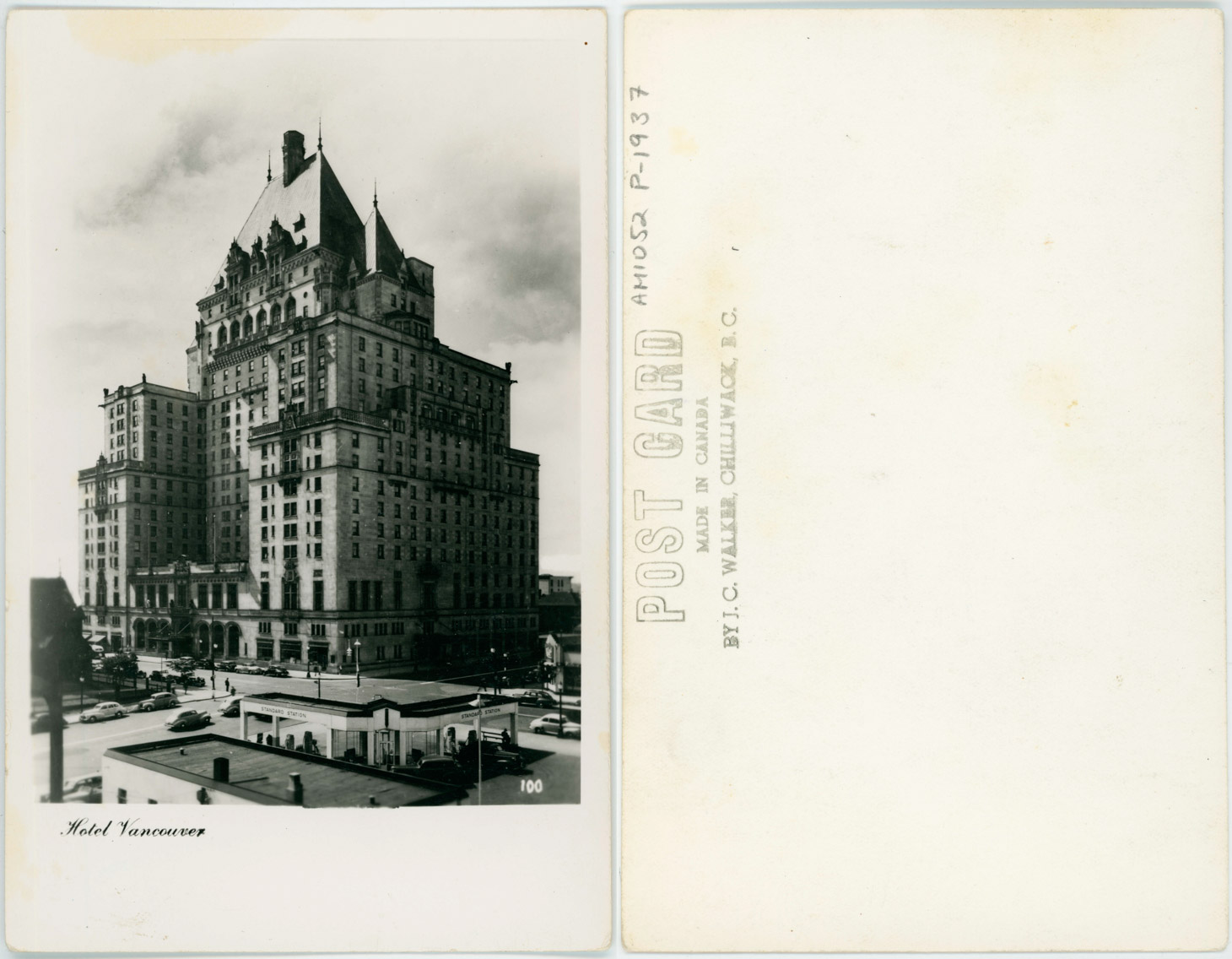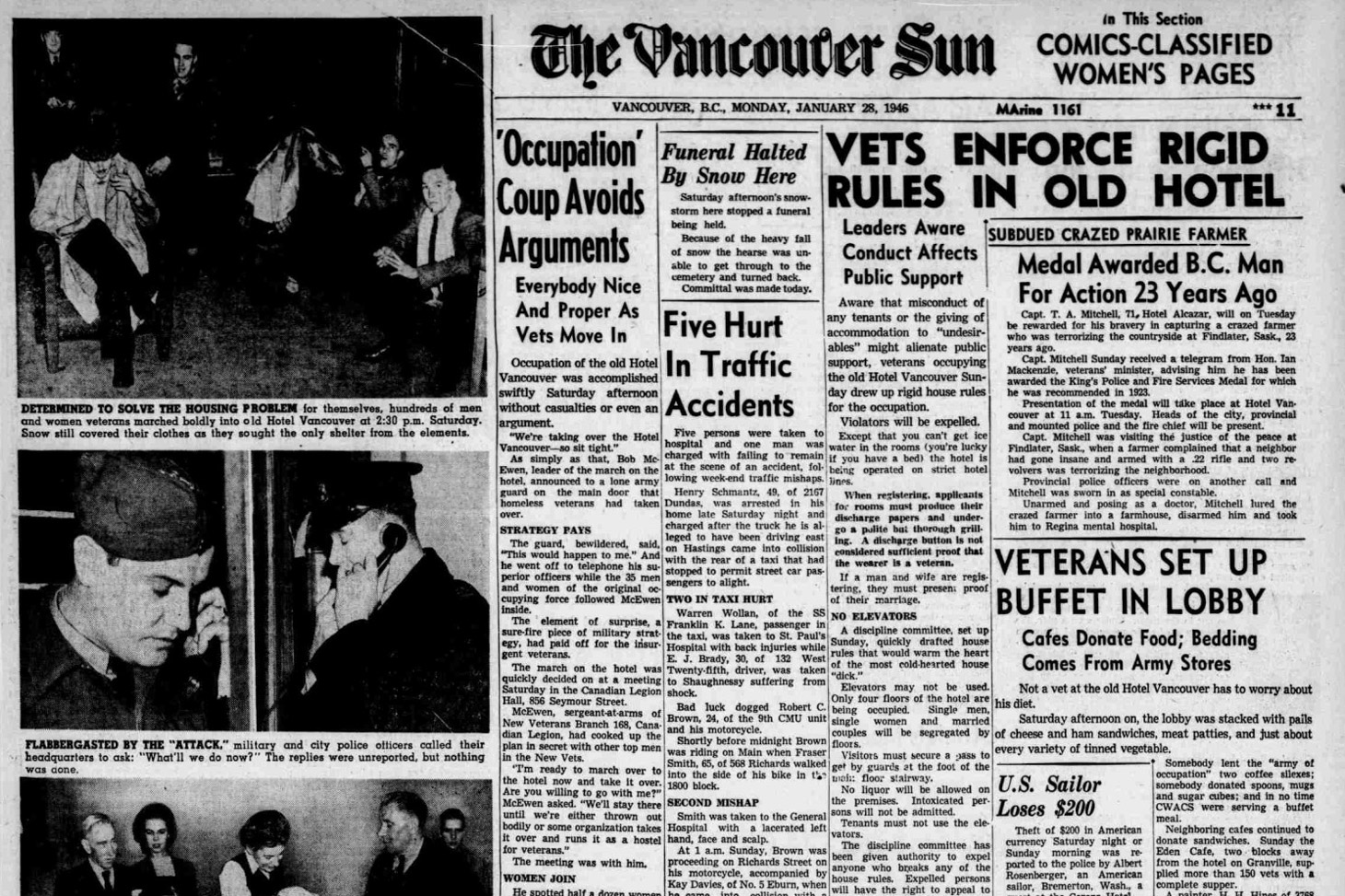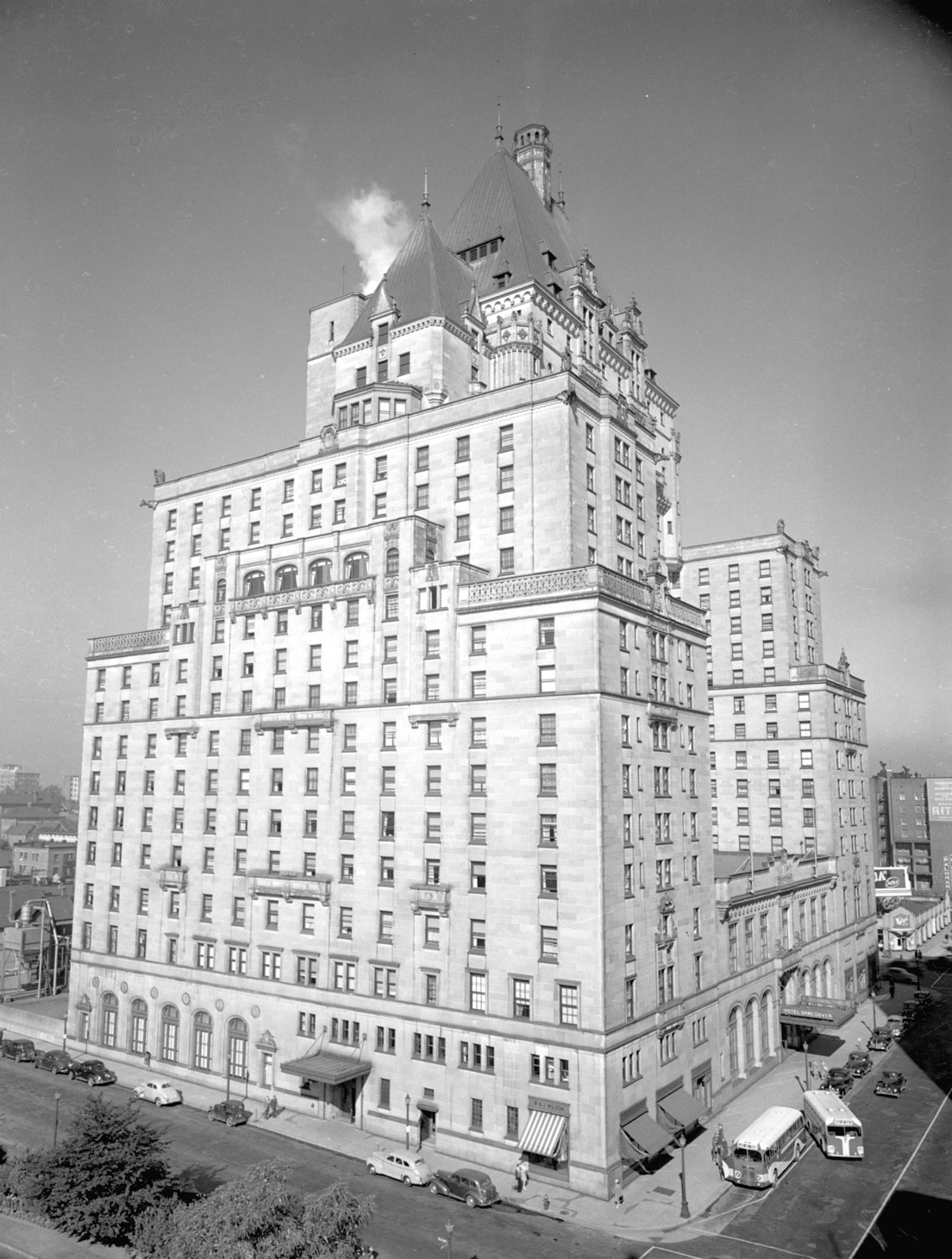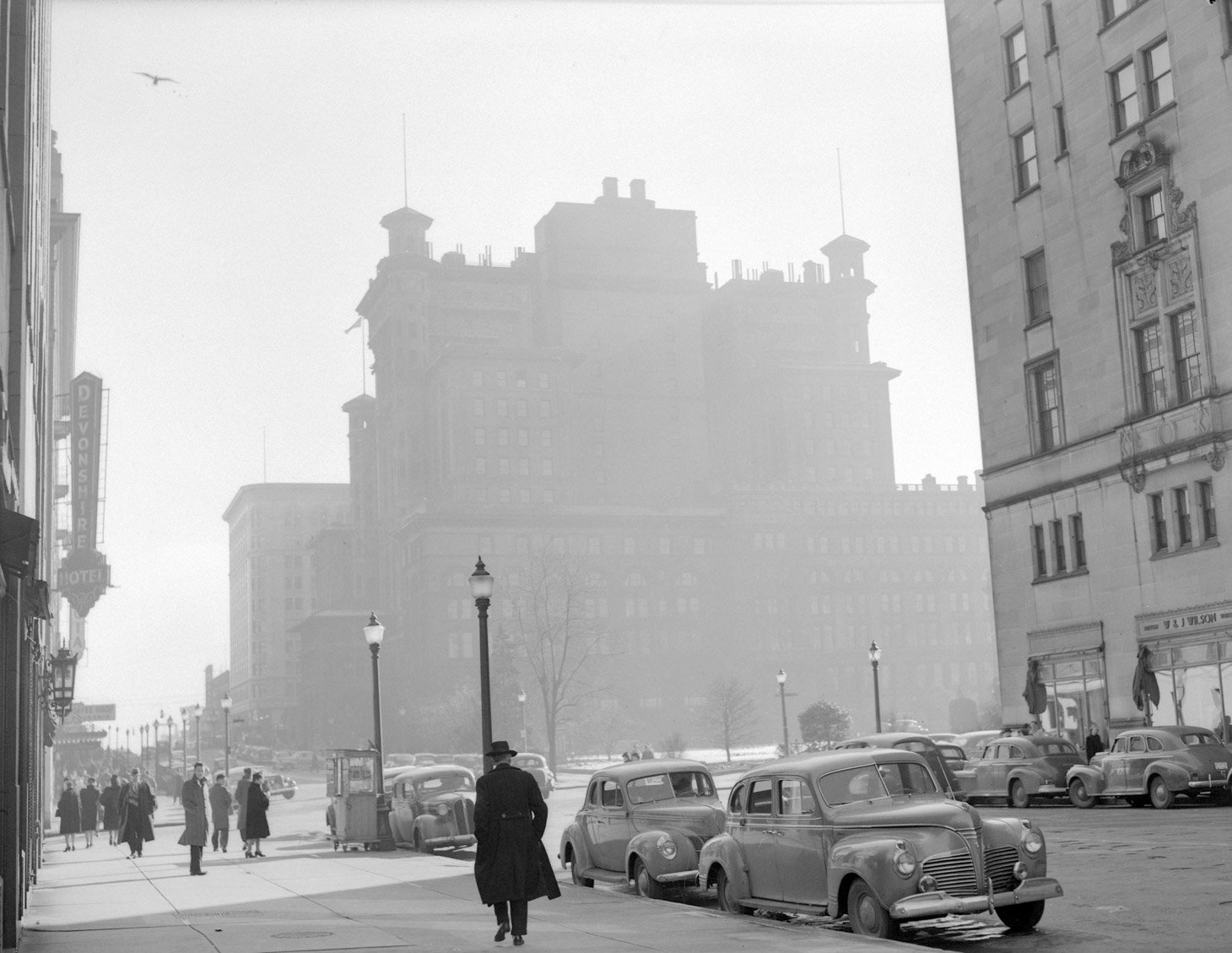“We’re taking over the Hotel Vancouver—sit tight.”
On Saturday, January 26, 1946, sergeant-at-arms Bob McEwen led 35 former servicemen and women from the Legion Hall to the old Hotel Vancouver. After announcing his intentions to the hotel security guard, McEwen and the other veterans swarmed inside and occupied the building. By 10 p.m., 100 veterans with their spouses and children were lodged within the hotel. In a time grimly familiar to our own—when a booming population, limited housing supply, increased immigration, and official inaction squeezed the housing market to its limit—this startling occupation forced a reluctant government to address the city’s postwar housing crisis, leading to affordable housing for veterans and their families.
The first Hotel Vancouver was built in 1888 by the Canadian Pacific Railroad, a six-storey building located at the intersection of Georgia and Granville streets. A CPR pamphlet touted the hotel as “situated on high ground near the centre of the city,” with “a glorious outlook in every direction.” In 1916 the hotel was replaced by a 15-story building on the same site. Over the years, the old Hotel Vancouver, as the site would become known, hosted celebrities including Babe Ruth, Charlie Chaplin, and Winston Churchill.
The hotel was vacated in 1939 when the CPR partnered with the Canadian National Railway and built a new hotel at Burrard and Georgia. According to Globe and Mail journalist Gordon McCallum, the new Hotel Vancouver “couldn’t be operated with any hope of profit if the old hotel were to be a competitor.” A scheduled demolition of the old building was postponed by the outbreak of the Second World War. During the war, the empty hotel was leased by the Department of National Defence as a recruitment centre, then later it served as barracks and office space.

A postcard dated 1937 shows the Hotel Vancouver. Courtesy of J.C. Walker, Vancouver Archives.
Canada faced numerous housing issues even before the war’s end. “By 1940, supply shortages, insufficient replacement of substandard housing and overcrowding … had created an enormous unsatisfied need for accommodation across the country,” writes historian Jill Wade in “A Palace for the Public”—a journal article chronicling the occupation of the hotel. The end of the Second World War added over 600,000 returning armed forces personnel and 43,000 immigrant war brides. National and local media, as well as business and labour journals, covered the housing crisis in detail.
Locally, one suggestion was to convert the old Hotel Vancouver into a hostel for returning service personnel. Support for the proposal grew among veterans’ organizations, housing advocacy groups such as the Citizens’ Rehabilitation Council of Greater Vancouver, and political organizations such as the Labour Progressive Party. In March 1945, a plan to buy and renovate the old Hotel Vancouver into temporary veterans’ housing was formally proposed. As Gordon McCallum wrote in The Globe and Mail, “If Ottawa could utilize the hotel to house men in uniform, why couldn’t it utilize it to house men who were just out of uniform—at least until the housing pinch was past?”
Despite widespread support, the project stalled. Local, provincial, and federal governments could not agree on issues of budget and oversight. “Negotiations were unnecessarily protracted, apparently irresolvable and occasionally maladroit,” writes Wade. “No local organization was willing to assume the management responsibilities and the financial risks inherent in the venture.”
Letters were sent to the prime minister and the heads of the various government departments in charge of housing. Advocates met with local leaders and city council. When letters and delegations failed, “The LPP and the veterans adopted more aggressive tactics,” Wade writes.
On New Year’s Day of 1946, veterans began picketing the old Hotel Vancouver. Bob McEwen, sergeant-at-arms with the New Veterans Branch of the Royal Canadian Legion, camped out on the courthouse lawn across from the hotel. McEwen had fought in the Sicilian campaign with the Seaforth Highlanders and been injured in 1944. When he returned to Vancouver after the war, he lived in his father’s apartment, sleeping “with his head in the gas oven and his feet in the sink,” according to an interview with The Tyee in 2006. With his new bride arriving from England any day, he urgently needed to find stable and affordable housing. McEwen and three others lit a bonfire on the courthouse lawn and brandished signs reading “Welcome Home. What Home? Where?”
With no end to the negotiations in sight, and snow on the ground, McEwen and his fellow legionnaires took matters into their own hands. At a meeting in the Legion Hall, McEwen said, “Let’s go and march into that old Vancouver Hotel and get some attention.”
According to the Sun, McEwen “spotted half a dozen women in the crowd and he asked them if they were willing to rough it in the unfurnished hotel. ‘That’s why we’re here,’ one of them shouted.”
McEwen led the members “in soldierly fashion” through “blinding snow” to the door of the hotel and announced they were taking it over. The coup was accomplished bloodlessly, with the hotel’s lone security guard muttering to himself, “This would happen to me,” and leaving to phone his superiors while McEwen and the others took over the building.

A clipping from the Vancouver Sun on January 28, 1946, reports on the occupation.
When two army officers arrived, they “merely shrugged and smiled when reporters asked if anything were going to be done about the vets’ invasion.” One of them asked McEwen about his plans. He responded, “Action’s got to come, we’ve waited six months. So here we are. We intend to stay here till we’re thrown out.”
That night, the veterans held a dance in the hotel’s Spanish Grill and Ballroom. Heating and some lighting worked, and the nearby Eden Café donated 150 meals to the occupiers. A hundred veterans chose rooms and bedded down on cots and mattresses. By the next day, 700 people had registered for rooms, and the occupiers were negotiating with the mayor and the director of veterans’ affairs. A 15-foot banner was hung outside the hotel, proclaiming “Action at Last Veterans! Rooms for you. Come and Get Them.”
In the hotel, house rules were drawn up and enforced. Registration meant showing discharge papers and undergoing “a polite but thorough grilling.” Single men, single women, and married couples were segregated on different floors. If a husband and wife registered, they had to show a marriage licence. Visitors required a pass, and a curfew was established. Committees were formed to inspect the fire equipment, handle sanitation and security, and operate the elevator once full electricity was restored.
Public support remained firmly behind the occupation. The minister of veterans affairs, Ian Mackenzie, was dispatched from Ottawa to look into the occupation and settle the future of the hotel. As Wade writes, “Mackenzie arrived in a snowy Vancouver on Monday morning’s train and, as federal representative, began serious negotiations with the veterans, the city council, the Rehabilitation Council and the CPR.” By the next day, Mackenzie announced that the federal government would pay $70,000 annually and the city $24,000 per year to help fund the hostel, and the Rehabilitation Council agreed to operate it. The veterans had accomplished their mission.
Asked in 2006 about the protest he led on that snowy Saturday in January 1946, Bob McEwen reflected, “I think you’d be slapped in jail pretty quick if you did that today.”
The occupation not only caused the transformation of the hotel into a veterans’ hostel, but it also led to longer-term solutions. The Renfrew Heights subdivision was built at Boundary Road and Grandview Highway, offering 600 units of permanent rental housing. “Many veterans and their families moved directly from the hotel to the new subdivision,” Wade writes. The Renfrew Heights houses were eventually offered for sale to their tenants. A generation of “project kids” grew up in this neighbourhood. As Denise Ryan wrote in The Vancouver Sun in 2017, “For a few glorious years, in an area of east Vancouver where the streets were named for wars—Vimy, Falaise, Mons, Dieppe—the children of Canada’s Second World War vets roamed like victorious soldiers.”

The Hotel Vancouver, photographed by Don Coltman in 1946. Courtesy of the Vancouver Archives.
While the third and current Hotel Vancouver is still operated by Fairmont Hotels and Resorts, the second hotel was torn down in January 1949, only 33 years after its construction. The hotel was replaced by a parking lot and later became the Pacific Centre shopping mall. Historian Eve Lazarus called the second hotel “the most elegant and ornate building that we ever destroyed,” but the website Historic Hotels of the World offered a different nickname: “Those familiar with Vancouver’s recent construction problems affectionately refer to this hotel as Vancouver’s first leaky condo.”
The veterans’ occupation of the Hotel Vancouver led to direct government action in addressing Vancouver’s housing crisis for one segment of its population. Writing about the lasting impact of the occupation, Wade reflects that “In this one instance, at least, popular pressure brought about measures, however temporary, to improve the accommodation of the Canadian people.”









